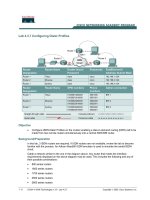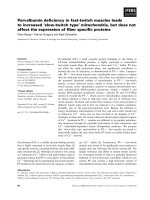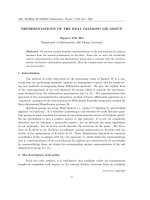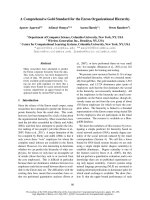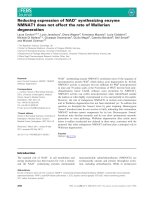Is obedience, not resistance, the real organizational change killer
Bạn đang xem bản rút gọn của tài liệu. Xem và tải ngay bản đầy đủ của tài liệu tại đây (484.6 KB, 15 trang )
VOLUME 13
Change Management
An International Journal
__________________________________________________________________________
Is Obedience, Not Resistance, the Real
Organizational Change Killer?
RON KOLLER, RICK FENWICK, AND RICK FENWICK, JR.
ontheorganization.com
CHANGE MANAGEMENT: AN INTERNATIONAL JOURNAL
www.ontheorganization.com
First published in 2013 in Champaign, Illinois, USA
by Common Ground Publishing LLC
www.commongroundpublishing.com
ISSN: 2327-798X
© 2013 (individual papers), the author(s)
© 2013 (selection and editorial matter) Common Ground
All rights reserved. Apart from fair dealing for the purposes
of study, research, criticism or review as permitted under the
applicable copyright legislation, no part of this work may be
reproduced by any process without written permission from the
publisher. For permissions and other inquiries, please contact
Change Management: An International Journal is
peer-reviewed, supported by rigorous processes of criterionreferenced article ranking and qualitative commentary,
ensuring that only intellectual work of the greatest substance
and highest significance is published.
Is Obedience, Not Resistance, the Real
Organizational Change Killer?
Ron Koller, Capella University, USA
Rick Fenwick, Capella University, USA
Rick Fenwick, Jr., Capella University, USA
Abstract: In peer-reviewed organizational change literature, most scholars have examined resistance to change (R2C)
and commitment to change (C2C) as separate, distinct constructs. Industry research often cites employee R2C as one of
the top reasons for organizational change initiative failure. Industry and scholarly researchers, alike, have studied many
facets of R2C, often making the value judgment that R2C is negative or an inhibitor of successful organizational change.
Most practitioners, and a handful of scholarly theorists, view R2C and C2C as opposite ends of the same spectrum. This
group also views reactions to organizational change in a value frame. The purpose of this paper is to examine the
behavioral reactions to change through a value free lens. Building upon the work of several different scholars, this
theoretical paper presents a new framework that includes R2C and C2C types of behaviors, but from a non-evaluative
point of view.
Keywords: Organizational change, Resistance to change, Commitment to change, Obedience
Introduction
S
eventy percent of change initiatives fail in achieving or sustaining the desired results
(Higgs and Rowland 2005, 121; Maurer 2010; Miller 2002; Pellettiere 2006; Warrick
2009). Though researchers cannot empirically confirm the seventy percent change
management failure rate (Hughes 2011, 451), the common observation is that organizational
change continues to wane (Burnes 2011, 446). Many managers see employees who resist change
as not being able to understand the situation (Cawsey and Deszca 2007) and think of highly
committed employees as individuals who understand the benefits of the change (Crosby and
Johnson 2003). This interpretation is self-serving and “acts as a defensive shield” (Cawsey and
Deszca, 2007, 178). It can result in a missed opportunity to engage workers and can create
unnecessary resistance. For example, Kotter describes four common reasons employees may
resist change to include self-interest, misunderstanding, different assessments of consequences,
and low tolerance for change (as cited in Cawsey and Deszca 2007).
While most researchers focus primarily on resistance to change (R2C) or commitment to
change (C2C), blind obedience is another expected employee response that few researchers have
examined as a part of the organizational change discussion (Cummings and Worley 2008).
When one thinks of psychology and obedience, the conversation often starts with Stanley
Milgram (1963) and the thought that authority figures manipulate unsuspecting people to
perform behaviors they would normally not perform without pressure from an authority figure.
Recent researchers (Perry 2012) have moved beyond the discussions of harming subjects and call
into question the face validity of Milgram’s conclusions.
For example, Milgram’s (1963) tightly controlled the experiments so that subjects were
acting in isolation from anyone but the authority figure. Subjects were unable to communicate
with other peers. This control, while making sense from a research perspective, does not reflect
the realities of the workplace. In most real world workplaces, individuals do not work in
complete isolation. They have the opportunity to advise a peer to say, “if you don’t think you
should do this, then don’t do it.”
Change Management: An International Journal
Volume 13, 2013, ontheorganization.com, ISSN: 2327-798X
© Common Ground, Ron Koller, Rick Fenwick, Rick Fenwick, Jr., All Rights Reserved
Permissions:
CHANGE MANAGEMENT: AN INTERNATIONAL JOURNAL
These experiments branded obedience as a destructive behavior. In organizational change,
managers do not say, “we expect you to obey,” yet it is an expected behavior as part of the
change process. The paradox lies in that managers lament that employees do not fully commit to
change, yet expect subordinates to be obedient to their every command (Paton and McCalman
2008, 183). In any change process, leadership assume that if they make a logical case for
change, then employees will obey the communication messaging and training programs often
accompanying strategic organizational change initiatives.
While managers may not be explicit in their expectation of obedience, they are more open
about their frustration with employee resistance. In the minds of managers, R2C is bad;
something that managers need to overcome (Coch and French 1948, 512; Bovey and Hede) as
opposed to being a logical reaction to a change which makes the employee’s job more difficult.
Recent research into the concept of positive deviance is arguing that some employee resistance is
good, and even essential (Spreitzer and Sonenshein 2004; Appelbaum et al. 2007).
On the other hand, C2C is something nearly all managers assume is good. To view R2C or
C2C as categorically good or bad is to make a value judgment. This evaluative approach can
lead to false assumptions because not all resistance is bad, nor is all commitment good.
Employees see change from a different perspective than leaders or change agents. Employees
who are blindly obedient cannot or do not point out critical problems or opportunities that result
in failure or stagnation of the change initiative. They are neither engaged nor motivated to
change.
Table 1 uses descriptors by scholarly theorists of R2C and C2C as constructs with optimal
and sub-optimal amounts, i.e. too little or too much are undesirable. If an employee
demonstrates not enough (passive) or too much (destructive) RTC, their behavior will negatively
impact the change. Similarly, if the employee does not show enough commitment (blind
obedience) or too much commitment (over-commitment), their behavior will negatively impact
the change.
Table 1 shows that when leaders or employee demonstrates an optimal amount of resistance
(not too little or too much), they improve the overall quality of the change initiative. However,
when leaders or employees demonstrate sub-optimal amounts of resistance (too much or too
little), their behavior negatively impacts the change. Constructive deviance is an existing term;
peak commitment is the term this paper uses to denote optimal commitment as supported by the
research of Randall (1987), Coetsee (1999), Morin et al. (2013), and Siegrist et al. (2004).
Optimal
Sub-optimal
Passive Resistance
Resistance to Change
Constructive Deviance
Destructive Deviance
Blind Obedience
Commitment to Change
Peak Commitment
Over-commitment
Figure 1: Optimization and Maximization Frames
If R2C and C2C can occur simultaneously in the same individual, what quantitative
constructs bind these behavioral forces? This paper presents The Behavioral Reactions to
Change model that focuses on an employee’s energy and compliance for change. It presents a
more comprehensive view of reactions to change considering both advantages and disadvantages
KOLLER, ET AL.: IS OBEDIENCE, NOT RESISTANCE, THE REAL CHANGE KILLER?
of R2C and C2C. This paper will explore an alternative concept of R2C and C2C that integrates
the constructs as part of a larger whole rather than as separate constructs. To do so requires a
different way of thinking than most empirical researchers utilize.
Many R2C researchers utilize a reductionist view that separates R2C from C2C.
Reductionism posits that the results of an organizational change are the sum total of the behavior
of the individuals undergoing that change. Martin and Dawda (2002, 39) describe the challenges
of maintaining such a view outside of the laboratory: “because many psychological phenomena
are complex, multidimensional, and context dependent, the attempted reduction of these
phenomena to a known set of constitutive elements for research purposes seldom is accomplished
without injury or alteration to the phenomena in question.” The reductionist point of view also
relies on linearity and maximization in arguing that too much R2C results in failure (Beer 2008;
Furst and Cable 2008, 453).
Few theorists and researchers have offered a comprehensive model to explain individual
behavior during a strategic organizational change (Oreg et al. 2011). One argument against
reductionism is that R2C and C2C can occur simultaneously and to a different degree within the
same employee or leader reacting to an organizational change (Foster 2010, 21). Judson (1991,
48) conceived of R2C and C2C as one continuum. Herscovitch and Meyer (2002, 475) tested
this theory, creating a resistance-to-commitment continuum metric. Both authors conceived of
the resistance-commitment continuum as being linear along one dimension.
Rather than using an evaluative frame to analyze R2C and C2C as separate constructs with
normative values, this paper will also introduce a non-evaluative frame to view the model. The
model attempts to present a more comprehensive view of reactions to change using R2C and
C2C as variables within a frame rather than each as within their own frames. The next sections
will highlight the R2C and C2C research and present the non-evaluative frame required to create
the model.
Resistance to change
Lawler and Worley (2011) argue that without the ability to change and adapt to an unstable
environment, organizations cannot sustain high performance. The majority of change processes
fail to successfully achieve desired goals (Beer 2003). Resistance to change is a common factor
cited as one of the reasons that organization change initiatives fail (Furst and Cable 2008, 453;
Lewis 2011).
Most theorists and researchers view R2C in one of two ways. The first view sees R2C as
neutral, impartial, and objective (Dent and Goldberg 1999, 25; Lewin 1947, 7). The second view
sees R2C as partial and subjective (Agboola and Salawu 2011, 237; Bovey and Hede 2001, 373;
Smollan 2011, 12). This paper will differentiate between these two views by using the term
non-evaluative for view one and evaluative for view two. Table 2 provides descriptors for R2C
used by both points of view. This table is not an exhaustive list, nor is it able to show any
overlaps; it is just a summary of basic terms.
Table 2: Frames of Resistance
Non-evaluative Frame
Evaluative Frame
Neutral
Factual
Mathematical
Mechanistic
Natural
The Rule
Good or bad
Judgmental
Perceptual
Emotional
Unnatural
Exceptional
CHANGE MANAGEMENT: AN INTERNATIONAL JOURNAL
The non-evaluative view of resistance is quantitative, meaning one can count a phenomenon
and conclude it is high or low. The evaluative view, on the other hand, relies on value judgments
from the observer rather than counting. In this view, researchers subjectively judge the value of
resistance as good or bad. The non-evaluative view sees resistance as a neutral and natural
phenomenon that is a product of the interaction between two or more people (Ford and Ford
2009, 214).
Lewin (1935, 58) infused the natural science of physics with the social science of
psychology when he conceived of resistance as a force driving toward equilibrium. The
evaluative view sees resistance as undesirable, something to be overcome (Coch and French
1948, 512; Moore 2011). The evaluative view assumes that resistance is the result of irrational
thinking (Bovey and Hede 2001, 373).
Some researchers have studied R2C using the mathematics of energy and force as a nonevaluative frame. Coetsee (1999, 208; 2011, 226) and O’Connor (1993, 32) conceived of
resistance to change as a phenomenon ranging from low to high-energy behaviors. Low energy
R2C behaviors include: apathy, indifference, and passivity. Managers often refer to this behavior
as passive resistance.
High-energy resistance behaviors include opposition, blocking, and subversion. Raes et al.
(2013, 173) and Cole et al. (2012, 446) explored the detrimental effects of high energy in
organizations. They posited a model with sub-optimal zones of comfortable energy/resigned
inertia, and corrosive energy. However, they inject values into their model by judging a
difference between good quality and bad quality energy.
Commitment to change
Conner and Patterson (1982, 19) argued that commitment was a threshold only achieved once an
individual worked through a preparation and acceptance phase. Researchers have used the
terms support and acceptance as synonyms in an organizational change context (Fedor, et al.
2006, 3). Ford and Ford (2009, 221) list compliance, acceptance, and agreement as separate
facets of commitment. Coetsee (1999, 208; 2011, 226) contends C2C has the same energy or
magnitude properties as R2C. He uses the term over-commitment for the highest magnitude
commitment.
Interestingly, no researchers postulate the commitment equivalent of passive resistance.
Two frequently used terms for low-energy commitment are apathy (Coetsee 1999, 208) and
compliance (Ford and Ford 2009, 221; Herscovitch and Meyer 2002, 475). Obedience is a term
not used in an organizational change context, but one that fits as a similar profile of someone
passively resisting. The Penguin Dictionary of Psychology (2013) defines obedience as “acting
in accordance with rules or orders. In most contemporary work in psychology, the term is used
as roughly synonymous with compliance” (para. 1). From the point of view that holds resistance
and commitment as mirror opposites, obedience is a suitable twin of passive resistance.
Milgram (1974) contends that obedience "consists in the fact that a person comes to view
himself as the instrument for carrying out another person's wishes, and he therefore no longer
regards himself as responsible for his actions” (xx). In laymen's terms this is saying, "hey, it's
not my fault this didn't work out … I was just doing what I was told." The presence of obedience
enables the blame cycle and finger pointing between upper management, change agents, middle
management, and employees. Obedience creates the illusion of commitment because individuals
are able to claim they are acting in accordance with management’s wishes.
The introduction of ISO 9000 in the 1990s rebranded the term compliance in organizations
(Brumm 1995, 73). Because of Sarbanes-Oxley, compliance is a common goal of Financial and
IT departments in recent times (Christensen and DeLoach, 2012). In academic research,
compliance (Cialdini and Goldstein, 2004) is only a short-term or one-time affirmative response.
KOLLER, ET AL.: IS OBEDIENCE, NOT RESISTANCE, THE REAL CHANGE KILLER?
It is not sustainable, which is why it requires watchdog auditors to continually police the new
policies created during a change initiative.
Integrative View of Resistance-Commitment Behaviors
While I-O psychologists generally reject behaviorism as a universal workplace theory of
performance (Landy and Conte 2010, 371), the stimulus-response portion may be relevant for
behavioral responses to organizational change. Though obedience is a lower form of
commitment (Cialdini and Goldstein 2004), a brief review of some recent R2C research is
required to understand its equivalent phenomenon relating to C2C. Nevin’s (2009) research
shows a stimulus-response bond in people experiencing R2C. If employee R2C is the response,
this begs the question what is the stimulus?
While early researchers explored management behavior as the primary stimuli of employee
R2C (Zander, 1950), most of the contemporary research on R2C eliminates smaller variables and
uses one broader variable, change. Organizational change is the stimulus, while employee R2C
is the response with irrational beliefs on the part of employees as the primary cause (Bovey and
Hede, 2001). Ford and Ford (2008) criticize the assumption underlying this contemporary R2C
research:
It’s true that resistance can be irrational and self-serving. But like it or not, it is an
important form of feedback. Dismissing it robs you of a powerful tool as you
implement change. It takes a strong leader to step up and engage when a change effort
meets with pushback. If you can gain perspective by paying attention to, understanding,
and learning from behaviors you perceive as threatening, you will ultimately deliver
better results. (100)
The implications for R2C and C2C theory are two-fold. First, rather than reducing R2C and
C2C down as static behaviors, a systemic frame is more appropriate, at least considering
management and change agent behavior as one of the stimuli of an employee’s response to
change. Second, the absence of resistance, though easier to manage, is not a successful change
strategy. Obedience or compliance responses are less effective than ownership and commitment
responses. Managers need to understand that their change leadership behavior causes a complex
range of responses that are not as simple as bad (resistance) or good (absence of
resistance/obedience).
The Judson (1991, 48) and Herscovitch and Meyer (2002, 475) linear view of the resistancecommitment continuum provides no explanation as to what binds these two phenomenon. In
further developing the concept, Coetsee (2011, 226) created a cycle, implying nonlinearity.
While not explicit, he implies that energy (intensity) is one force that explains a bound
resistance-commitment concept. From a two-dimensional model perspective, this energy could
serve as one axis.
Organizational deviance is another field of study that examines R2C and C2C at the same
time (Leavy 2011, 20; Pascale et al. 2010, 16). While most organizations will fire an individual
exhibiting deviant behavior, these researchers simply equate deviance to mean departure from the
norm (Ferris et al. 2009, 279; Lawrence and Robinson, 2007, 380). Research on deviance in
organizations focuses on the degree of compliance an individual exhibits in the workplace
(Warren 2005, 132). Compliance is the second possibility of a force that involves both resistance
and commitment, and could serve as another axis for a two-dimensional model. Managers
characterize a noncompliant individual as resistant and a compliant individual as committed to a
change.
CHANGE MANAGEMENT: AN INTERNATIONAL JOURNAL
Behavioral Reactions to Change Model
A 60-year review of quantitative studies of commitment to organizational change literature (Oreg
et al. 2011) concluded: “The main determinant of the extent to which any change can succeed, is
how change recipients react to organizational change” (2). The integrative frame (theory) and
corresponding planned empirical research is attempting to create a model that more accurately
explains change recipient reactions to change that are traditionally conceived of as either R2C or
C2C behaviors. The prior section introduced energy and compliance as two distinct concepts
that explain the binding of resistance and commitment as a two-dimensional or nonlinear
construct.
The model offers a way of examining the dynamics of change. It assumes that a person’s
behavior is dynamic and their level of energy relative to a change may shift over time. An
individual’s energy for a change fluctuates over time because of a wide variety of reason.
Compliance to the standards of a change also fluctuates over time, both because management
cannot constantly monitor behavior and the standard of compliance is managed inconsistently.
The model in Figure 1 illustrates the four quadrants based upon levels of energy and levels of
compliance. In any organizational change scenario, employees will fall into one of the four
quadrants based upon their level of compliance and their level of energy. Listed in each quadrant
are the titles and attitudes that tie in with each category.
Figure 1: Behavioral Reactions to Change Model
In Figure 1, the vertical axis represents energy (low to high), while the horizontal axis
represents compliance (low to high). The descriptor for a person’s behavior depends upon this
combination of energy and compliance. For example, if a person has low energy and is
noncompliant, their behavior is described as inactivity. Low energy and compliant is described
as obedience. High energy and noncompliant is described as opposition, while high energy and
KOLLER, ET AL.: IS OBEDIENCE, NOT RESISTANCE, THE REAL CHANGE KILLER?
compliant behavior is described as ownership. Figure 1 also contains synonyms or equivalent
behaviors for each of the four quadrants. The rest of this section will provide a brief explanation
of each quadrant, as well as an important role that nonlinearity plays in this model, a
phenomenon also referred to as dynamism.
Inactivity
If a person has low energy and is noncompliant, their behavior is described as inactive. It can be
expressed in different forms to include apathy, passivity, procrastination, or busywork. When a
person experiences apathy, they passively resist change. They do not think it will work nor do
they care; they are resigned to their leader’s requests for action. A person who is cynical towards
leaders and the work often resides in this quadrant for many organizational changes.
Obedience
Low energy and compliant is described as obedient. A person who is obedient with low energy
is looking for the path of least resistance. They will accept what comes their way as the best way
to avoid conflict. They have surrendered to making a difference with their own behavior. They
are often skeptical of leaders and work. They do not believe the change will work, but they will
accept what they are asked to do.
Opposition
If a person has high energy and is noncompliant, they are in opposition to change. They create
conflict and are actively resistant to changes. These individuals will disobey to the point of
obstruction. Their high energy is reflective of a high level of caring as well, although they do not
consider any damage caused from their opposition. They feel strongly about their ideas relative
to the change. They may advocate for an alternative or for status quo.
Ownership
If a person has high energy and is compliant, they have taken ownership for the change. They
believe in the change and are an advocate. They actively support the change and have
enthusiasm for it as well. They are invested in the original change plan and the predicted
outcomes. They often, however, do not have the support of their peers and eventually experience
burnout as the change evolves.
Dynamism
Individuals are unable to sustain high levels of energy indefinitely. It is abnormal to sustain high
(or low) levels of energy for a particular change at all times. A person who takes ownership for
change may have a period where they are obedient and using less energy. A person who opposed
the change may become inactive for periods. The reverse flow of energy is also expected.
Compliance will fluctuate and flow in both directions as well. A person who opposed
change and is empowered to self-organize the change process may move to ownership more
quickly than the resigned individual who lacks energy and enthusiasm. Inactive individuals often
move to obedience when they are no longer able to evade monitoring and run out of excuses
about why they cannot comply.
CHANGE MANAGEMENT: AN INTERNATIONAL JOURNAL
Implications for Management, Researchers, and Practitioners
Ownership for a change and obedience to a change are two different responses. Managers need
to understand that they stimulate ownership or obedience when they lead change whether they
realize it or not. Employees who openly support change have energy, while employees who are
obedient to change lack energy. Nadler and Tushman (1989, 198) argued that initiating and
implementing organizational change requires energy. Does the way a manager extinguishes
resistance also unintentionally quell support for a change?
Many researchers have explored resistance as “bad” and commitment as “good.” This
subjective point of view reinforces management’s assumption that part of their job is to drive out
all resistance. Science attempts to reduce value judgments and maintain neutrality/objectivity.
This paper has argued for a more objective way to study the dynamics of individual reactions to
organizational change in an integrated fashion.
The hypothesized model contains quantitative concepts demonstrating magnitude/strength,
rather than a value judgment. This model considers the dynamism of change and looks beyond
resistance and commitment as value judged (qualitative) concepts. In doing this, the model
offers greater explanatory power in understanding the dynamics of change. Empirical data
gathering to test this theory will begin shortly.
KOLLER, ET AL.: IS OBEDIENCE, NOT RESISTANCE, THE REAL CHANGE KILLER?
REFERENCES
Agboola, Akinlolu A., and Rafiu O. Salawu. 2011. “Managing deviant behavior and resistance to
change.” International Journal Of Business & Management 61: 235-42.
Appelbaum, Steven H., Giulio D. Iaconi, and Albert Matousek. 2007. "Positive and negative
deviant workplace behaviors: causes, impacts, and solutions." Corporate Governance 7:
586-98. doi: 10.1108/14720700710827176
Beer, Michael. 2003. “Why total quality management programs do not persist: The role of
management quality and implications for leading a TQM transformation.” Decision
Sciences 34: 623-42. doi: 10.1111/j.1540-5414.2003.02640.x.
Bovey, Wayne, and Andrew A. Hede. 2001. “Resistance to organizational change: The role of
defense mechanisms.” Journal of Managerial Psychology 167: 534-48. doi:
10.1108/EUM0000000006166.
Brumm, Eugenia. 1995. “Managing records for ISO 9000 compliance.” Quality Progress 281:
73-78.
Burnes, Bernard. 2011. “Introduction: Why does change fail, and what can we do about
it?” Journal
Of
Change
Management
114:
445-50.
doi:
10.1080/14697017.2011.630507.
Cawsey, Tupper, and Gene Deszca. 2007. Toolkit for organizational change. Los Angeles, CA:
Sage.
Christensen, Brian, and Jim DeLoach. 2012. “How Sarbanes-Oxley has affected internal controls
and compliance: A 10th anniversary review.” Global Association of Risk Professionals.
Retrieved
from
/>Cialdini, Robert, and Noah Goldstein. 2004. “Social influence: Compliance and conformity.”
Annual
Review
of
Psychology 551:
591-21. doi:
10.1146/annurev.psych.55.090902.142015.
Coch, Lester, and John R. P. French. 1948. “Overcoming resistance to change.” Human
Relations 14: 512–32. doi: 10.1177/001872674800100408.
Coetsee, Leon. 1999. “From resistance to commitment.” Public Administration Quarterly 232:
204-22. Retrieved from Proquest Psychology database.
—. 2011. Peak performance and productivity: A practical guide for the creation of a motivating
climate. Potchefstroom: Andcork Publishers.
Cole, Michael, Heike Bruch, and Bernd Vogel. 2012. “Energy at work: A measurement
validation and linkage to unit effectiveness.” Journal of Organizational Behavior 334:
445−67. doi: 10.1177/0018726712454554.
Conner, Daryl, and Robert Patterson. 1982. “Building commitment to organizational change.”
Training & Development Journal 364: 18-30. Retrieved from Ebscohost database.
Crosby, Lawrence, and Sheree L. Johnson. 2003. “Watch what I do: Leadership behavior sends
the strongest message.” Marketing Management 126: 10-11. Retrieved from Ebscohost
database.
Cummings, Thomas, and Christopher G. Worley. 2008. Organization development and change.
9th ed. Mason, OH: Cengage Learning.
Dent, Eric, and Susan G. Goldberg. 1999. “Challenging ‘resistance to change.’" Journal of
Applied Behavioral Science 351: 25-41. doi: 10.1177/0021886399351003.
Fedor, Donald, Steven Caldwell, and David M. Heller. 2006. “The effects of organizational
changes on employee commitment: A multi-level investigation.” Personnel Psychology
591: 1–29. doi: 10.1111/j.1744-6570.2006.00852.x.
Ferris, D. Lance, Douglas J. Brown, and Daniel Heller. 2009. “Organizational supports and
organizational deviance: The mediating role of organization-based self-esteem.”
CHANGE MANAGEMENT: AN INTERNATIONAL JOURNAL
Organizational Behavior and Human Decision Processes 1082: 279-86. doi:
10.1016/j.obhdp.2008.09.001.
Ford, Jeffrey, and Laurie W. Ford. 2009. “Resistance to change: A reexamination and
extension.” Research in Organizational Change and Development 17: 211-39.
Foster, Rex. 2010. “Resistance, justice, and commitment to change.” Human Resource
Development Quarterly 21: 3-39.
Furst, Stacie, and Daniel M. Cable. 2008. “Employee resistance to organizational change:
Managerial influence tactics and leader-member exchange.” Journal of Applied
Psychology 932: 453-62. doi: 10.1037/0021-9010.93.2.453.
Herscovitch, Lynne, and John P. Meyer. 2002. “Commitment to organizational change:
Extension of a three-component model.” Journal of Applied Psychology 87: 474-87.
doi: 10.1037/0021-9010.87.3.474.
Higgs, Malcolm, and Deborah Rowland. 2005. “All changes great and small: Exploring
approaches to change and its leadership.” Journal of Change Management 52: 121-51.
doi: 10.1080/14697010500082902.
Hughes, Mark. 2011. “Do 70 percent of all organizational change initiatives really fail?” Journal
Of Change Management 114: 451-64. doi: 10.1080/14697017.2011.630506.
Judson, Arnold. 1991. Changing behavior in organizations: Minimizing resistance to change.
Cambridge: Blackwell Publishing.
Landy, Frank, and Jeffrey M. Conte. 2009. Work in the 21st century: An introduction to industrial
and organizational psychology. 3rd ed. Boston, MA: Wiley-Blackwell.
Lawler III, Edward, and Christopher G. Worley. 2011. Built to change: How to achieve sustained
organizational effectiveness. San Francisco, CA: Jossey-Bass.
Lawrence, Thomas, and Sandra L. Robinson. 2007. “Ain't misbehavin: Workplace deviance as
organizational
resistance.” Journal
of
Management 333:
378-94.
doi:
10.1177/0149206307300816.
Leavy, Brian. 2011. “Leading adaptive change by harnessing the power of positive deviance.”
Strategy & Leadership 392: 18-27. doi: 10.1108/10878571111114437.
Lewin, Kurt. 1935. A dynamic theory of personality. New York: McGraw-Hill.
—. 1947. “Frontiers in group dynamics: Concept, method, and reality in social science.” Human
Relations 11: 5-42. doi: 10.1177/001872674700100103.
Lewis, Laurie. Organizational change: Creating change through strategic communication.
Chichester, UK: Wiley-Blackwell.
Martin, Jack, and Darek Dawda. 2002. "Reductionism in the Comments and Autobiographical
Accounts of Prominent Psychologists." The Journal of Psychology 136: 37-52.
Retrieved from Proquest database..
Maurer, Rick. 2010. Why so many changes fail—and what you can do about it. Retrieved from
/>Milgram, Stanley. 1963. “Behavioral study of obedience.” Journal of Abnormal and Social
Psychology 674: 371-78. doi: 10.1037/h0040525.
—. 1974. Obedience to authority: An experimental view. New York, NY: Harper and Row.
Miller, David. 2002. “Successful change leaders: What makes them? What do they do that is
different? Journal of Change Management 24: 359-68. Retrieved from EBSCOhost
database.
Moore, David. 2011. “Overcoming resistance: Company stories helping to change learning.”
Training & Development In Australia 381: 16-17. Retrieved from EBSCOhost
database.
Morin, Alexandre, Vandenberghe, Christian, Turmel, Marie, Madore, Isabelle, and Christophe
Maiano. 2013. “Probing into commitment’s nonlinear relationships to work outcomes.”
Journal of Managerial Psychology 28: 202-23. doi: 10.1108/02683941311300739.
KOLLER, ET AL.: IS OBEDIENCE, NOT RESISTANCE, THE REAL CHANGE KILLER?
Nadler, David, and Michael L. Tushman. 1989. “Organizational frame bending: Principles for
managing reorientation.” Academy Of Management Executive 33: 194-204. doi:
10.5465/AME.1989.4274738.
Nevin, John. 1999. “Analyzing Thorndike’s law of effect: The questions of stimulus-response
bonds.” Journal of the Experimental Analysis of Behavior 72: 447-50. doi:
10.1901/jeab.1999.72-447.
Obedience. 2009. In The Penguin Dictionary of Psychology. Retrieved from Credoreference
database.
O’Connor, Carol. 1993. “Resistance: The repercussions of change.” Leadership & Organization
Development Journal, 146: 30-36. Retrieved from Proquest Psychology database.
Oreg, Shaul, Maria Vakola, and Achilles Armenakis. 2011. “Change recipients' reactions to
organizational change: A 60-year review of quantitative studies.” The Journal of
Applied Behavioral Science 474: 461-524. doi: 10.1177/0021886310396550.
Pascale, Richard T., Jerry Sternin, and Monique Sternin. 2010. The power of positive deviance:
How unlikely innovators solve the world's toughest problems. Cambridge, MA: Harvard
Business School Press.
Paton, Robert, and James McCalman. 2008. Change management: A guide to effective
implementation. Thousand Oaks, CA: Sage.
Pellettiere, Vincent. 2006. “Organization self-assessment to determine the readiness and risk for
a planned change.” Organization Development Journal 244: 38-43. Retrieved from
EBSCOhost database.
Raes, Anneloes, Heike Bruch, and Simon De Jong. 2013. “How top management team
behavioural integration can impact employee work outcomes: Theory development and
first empirical tests.” Human Relations 662: 167-92. doi: 10.1177/0018726712454554.
Randall, Donna. 1987. “Commitment and the organization: The organization man revisited.”
Academy of Management Review 12: 460-71.
Siegrist, Johannes, Dagmar Starke, Tarani Chandola, Isabelle Godin, Michael Marmot, Isabelle
Niedhammer, and Richard Peter. 2004. “The measurement of effort-reward imbalance at
work: Europeans comparisons.” Social Science & Medicine 58: 1483-99.
Smollan, Roy. 2011. “Engaging with Resistance to Change.” University Of Auckland Business
Review 131: 12-15. Retrieved from EBSCOhost database.
Spreitzer, Gretchen M., and Scott Sonenshein. 2004. "Toward the construct definition of positive
deviance." American Behavioral Scientist 47: 828-847.
Warren, Danielle. 2005. “Managing noncompliance in the workplace,” in Managing
organizational deviance, edited by Roland E. Kidwell and Christopher L. Martin, 131–
50. Thousand Oaks, CA: Sage.
Warrick, Don. 2009. “Developing organizational change champions.” OD Practitioner 411: 1419. Retrieved from EBSCOhost database.
Zander, Alvin. 1950. “Resistance to change-its analysis and prevention.” Advanced Management
Journal 4: 9-11.
CHANGE MANAGEMENT: AN INTERNATIONAL JOURNAL
ABOUT THE AUTHORS
Ron Koller: Ron is a doctoral student at Capella University. He co-authored Whole-Scale
Change and the Whole-Scale Change Toolkit (Berrett-Koehler, 2000). Ron worked for Kathie
Dannemiller, learning first hand accounts of the work of Kurt Lewin and Ron Lippitt. His
industry work and scholarly research are a continuation of their work and can be found at
www.ChangeStudy.com.
Dr. Rick Fenwick: Rick has mentored I-O Psychology and Leadership doctoral dissertation
students at Capella University and the University of Phoenix. He is also a partner at Fenwick
Koller Associates providing organization development consulting focusing on implementing
change. Rick has a Ph. D. in Organizational and Social Psychology from the Union Institute.
Rick Fenwick, Jr.: Rick Fenwick Jr. is a doctoral learner at Capella University. His
specialization area is change management in union environments. Rick has helped to pioneer a
model of team-based culture change at General Motors. He is also a consultant with Fenwick
Koller Associates.
Change Management: An International Journal
is one of four thematically focused journals in the
collection of journals that support The Organization
knowledge community—its journals, book series,
conference and online community.
The journal investigates the dynamics of negotiating
organizational change, and organizational responses
to social, stakeholder and market change.
As well as papers of a traditional scholarly type, this
journal invites case studies that take the form of
presentations of management practice—including
documentation of organizational practices and
exegeses analyzing the effects of those practices.
Change Management: An International Journal is a
peer-reviewed scholarly journal.
ISSN 2327-798X


